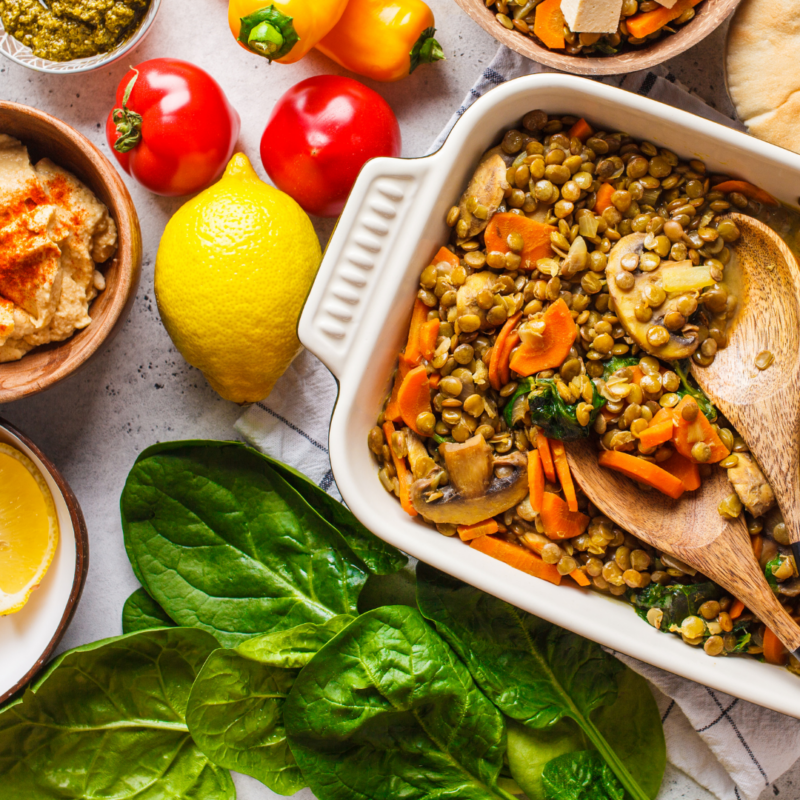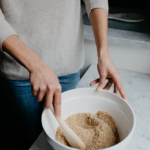If you want to eat more plant-based, but not sure what ingredients to buy for your meals, you’re not alone. A recent 2020 survey conducted by researchers at Yale and the Earth Day Network found that over half of Americans are open to eating plant-based meals, but don’t know what to buy.
Moreover, many people are under the misconception that omitting meat can be expensive, but fortunately, that is a myth. We’ve rounded up our favorite hacks on how to eat plant-based on a budget:
1. Stick to whole foods instead of “convenience” foods.
When it comes to a plant-based diet, some of the first things that may come to your mind are alternative meats like the Beyond Burger or Impossible Burger. Believe it or not, these plant-based meat alternatives are actually more expensive than traditional whole foods. They’re also filled with processed ingredients such as food colorings and hydrogenated oils, so experts recommend eating them in moderation.
If you are a fan of plant-based meat, you may want to try making burger patties yourself at home with whole foods. There are a variety of options that are relatively inexpensive at the store such as brown rice, beans, lentils, and peas that can be used in a variety of dishes and cuisines.
2. Make a grocery list before your trip to the supermarket.
Making a trip to the grocery store can feel like an adventure sometimes. We’ve all had our moments when we search aisle after aisle and add things into our cart that we never even planned on purchasing in the first place. One way you can avoid spending more money than you intend to is by creating a grocery list before your trip to the supermarket.
Build a list which products you plan to buy and if it’s helpful, add what aisle those products are in at the grocery store. Additionally, remember to view the weekly ad at your local store before your trip so you do not miss out on any sales. During your trip, make sure to buy everything on your list and if you see a product that’s off-list, but grabs your interest, make a plan for that: You can budget an amount for spontaneous products ahead of time so you don’t miss out on something you really want to try.
3. Buy your food in bulk or family size.
If you want a hefty discount on your favorite plant-based products, you may want to consider buying them in bulk. However, not all foods lend themselves to mass buying, especially fresh fruit and vegetables as they are perishable.
Only purchase items in bulk that have a high shelf-life like canned vegetables, pasta, rice, beans, and bags of frozen food (yes, frozen vegetables are just as nutritious – if not more so 0 than fresh vegetables!). A lot of these items can be purchased at grocery warehouses like Costco, Sam’s Club, and Gordon Food Service Store. You can also order them online via Amazon or directly from the product’s official site.
4. Engage in batch cooking and freeze larger meals.
If you don’t like cooking often, this tip is definitely for you. Batch cooking is a convenient method of meal preparation which involves cooking in batches. Basically, it entails cooking a bunch of dishes at once – like once a week – and having them ready for weeknight meals.
Some of the simplest dishes to make ahead for the week include soups, stir-fries, and salads. Make sure to store all of your dishes in an airtight container and store condiments on the side, such as salad dressings or dips, so the food stays fresh and does not become soggy. If you do not prefer to eat the same meal every week, you can do something like boiling beans or lentils ahead of time to use in a variety of different dishes such as tacos, stews, or soups.
5. Adhere to the “dirty dozen” and “clean fifteen” when purchasing produce.
Eating organic can be what drives up the cost of planning primarily plant-based meals, but learning which fruits and vegetables are listed in the “dirty dozen” and “clean fifteen” can help you stay within your budget. Certain fruits and vegetables that have a thicker exterior (think avocado, pineapple, bananas) aren’t as necessary to buy organic because the flesh (i.e. the part that you eat) is less likely to be contaminated. Leafy greens, berries, and apples for example are safer when organic.









